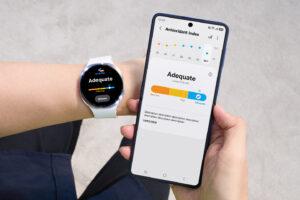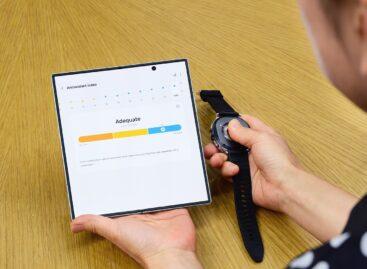From the lab to your wrist: cutting-edge nutrition tracking technology comes to the Galaxy Watch
It all started with a simple question: what if we could track our nutrition in real time, right from our wrist? The Antioxidant Index on the Samsung Galaxy Watch8 brings what once seemed like science fiction to everyday use. With a scan of your thumb, you can get accurate carotenoid levels in as little as five seconds[i] – this nutritional index could set the industry standard.
 A scaled-down version of lab-grade sensor technology with exceptional accuracy could turn our diet into a usable metric for healthier aging. Setting the new standard in wearable health tracking took years of intensive research, countless prototypes and relentless development.
A scaled-down version of lab-grade sensor technology with exceptional accuracy could turn our diet into a usable metric for healthier aging. Setting the new standard in wearable health tracking took years of intensive research, countless prototypes and relentless development.
New Perspectives on Nutrition Tracking
In 2018, Samsung found a major gap in wearables: We could count every step and calorie we took, but there was no easy way to measure how our diet was affecting our health. Deeper insights into nutrition were tied to expensive and time-consuming lab tests that were out of reach for many.
As people live longer, the focus is shifting from extra years to improving quality of life. “In this context, anti-oxidants naturally come to the fore as a way to slow down aging,” explains Dr. Hyojee Joung, a public health nutritionist at Seoul National University[ii] who was involved in the development of the technology. “If antioxidants are neglected, reactive oxygen species (ROS) can accumulate in the body, increasing the risk of chronic diseases such as cardiovascular disease, diabetes and cancer.”
This realization made antioxidants a cornerstone of Samsung’s mission. Engineers and scientists focused on carotenoids—key antioxidants and proven indicators of fruit and vegetable consumption—to create a device that is small enough to wear on the wrist, yet powerful enough to translate complex antioxidant data into simple, actionable wellness information for anyone.
1. The challenge: how to shrink lab-scale sensor technology?
The concept of a wearable nutrition tracker was a challenge from day one. Traditional methods for measuring carotenoid levels, such as Raman spectroscopy, are laser-based, non-invasive, and accurate, but they rely on bulky machines that are not wearable at all. So the team’s first mission was to shrink the lab-scale technology into a wrist-mounted sensor.
After seven years of rigorous testing and optimization—since the first prototype—the team developed the BioActive sensor, a breakthrough technology that combines LEDs of different wavelengths with a unique photodetector array to provide accurate carotenoid readings in a compact package.
“Our breakthrough was integrating reflectance spectroscopy with LEDs, which allowed us to miniaturize the technology while maintaining a high level of accuracy,” explains Jinyoung Park, a developer at Samsung’s Digital Health team.
Unlike lasers, which emit a sharp, narrow wavelength, LEDs use a wider range of wavelengths. By using photodiodes[iii] to analyze how much light the skin absorbs across multiple wavelengths, the smartwatch can estimate carotenoid levels. Advanced algorithms that continuously calibrate in real time can also support accuracy while providing personalized information to each user.
Challenge 2: How to bring the technology to everyone?
Creating a coin-sized carotenoid sensor was a major milestone. The next challenge was for Samsung to ensure the sensor would work accurately and reliably across different skin types, making it truly accessible to everyone.
To overcome the challenges of melanin interference across different skin tones, Samsung engineers decided to measure at the fingertip, as this area of the body contains the least melanin across all ethnicities. They also made simple changes: applying slight pressure to the fingertip during scanning can temporarily reduce blood flow and hemoglobin interference, making the results much more accurate.
The sensor’s performance was validated through extensive testing at the Samsung Medical Center[iv], involving hundreds of participants. This paved the way for a feature that could seamlessly transition from the lab to users worldwide, offering an inclusive solution designed for everyday life.
How does it work?
Carotenoids are natural red pigments found in fruits and vegetables.
Related news
Broccoli is already in your head, but it’s a long way to the plate
🎧 Hallgasd a cikket: Lejátszás Szünet Folytatás Leállítás Nyelv: Auto…
Read more >Cutting-edge nutrition tracking technology is now available on the Galaxy Watch
🎧 Hallgasd a cikket: Lejátszás Szünet Folytatás Leállítás Nyelv: Auto…
Read more >This is why you should pay attention to your heart health even in autumn – tips from a dietitian
🎧 Hallgasd a cikket: Lejátszás Szünet Folytatás Leállítás Nyelv: Auto…
Read more >Related news
The HORECA sector joins forces with Alimentaria+Hostelco to mark the future of hospitality
🎧 Hallgasd a cikket: Lejátszás Szünet Folytatás Leállítás Nyelv: Auto…
Read more >Challenges of the retail sector: retail has become more crisis-resistant
🎧 Hallgasd a cikket: Lejátszás Szünet Folytatás Leállítás Nyelv: Auto…
Read more >How to avoid the hassles of online shopping?
🎧 Hallgasd a cikket: Lejátszás Szünet Folytatás Leállítás Nyelv: Auto…
Read more >






